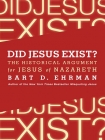Did Jesus Exist? - The Historical Argument for Jesus of Nazareth Bart Ehrman (books to read in your 20s txt) 📖

- Author: Bart Ehrman
Book online «Did Jesus Exist? - The Historical Argument for Jesus of Nazareth Bart Ehrman (books to read in your 20s txt) 📖». Author Bart Ehrman
4. Mettinger, Riddle of the Resurrection, 219.
5. Mettinger, Riddle of the Resurrection, 221.
6. Jonathan Z. Smith, “Dying and Rising Gods,” Encyclopedia of Religion, 2nd ed., ed. Lindsay Jones (Detroit: Macmillan, 2005), 4:2535–40.
7. J. Z. Smith, “Dying and Rising Gods,” 2535.
8. J. Z. Smith, “Dying and Rising Gods,” 2538.
9. Mark S. Smith, “The Death of ‘Dying and Rising God’ in the Biblical World: An Update, with Special Reference to Baal in the Baal Cycle,” Scandinavian Journal of the Old Testament 12 (1998): 257–313.
10. M. S. Smith, “Death of ‘Dying and Rising Gods,’” 288.
11. Most famous is Ralph Martin, A Hymn of Christ: Philippians 2:5–11 in Recent Interpretation and in the Setting of Early Christian Worship (Downers Grove, IL: Intervarsity Press, 1997). See also the useful collection of essays in Ralph Martin and Brian Dodd, eds., Where Christology Began: Essays on Philippians 2 (Louisville, KY: Westminster John Knox Press, 1998).
12. Few scholars take the latter view, but one who does is Gordon Fee, Paul’s Letter to the Philippians, New International Commentary on the Bible (Grand Rapids, MI: Eerdmans, 1995).
13. To get a sense of the richness of the interpretive tradition, see, for example, the commentary by John Reumann, Philippians: A New Translation with Introduction and Commentary, Yale Anchor Bible (New Haven, CT: Yale Univ. Press, 2008), 338–83.
14. For a brief statement of this view, see the essay by James D. G. Dunn, “Christ, Adam, and Preexistence,” in Where Christology Began, ed. Martin and Dodd, 74–83.
15. See Alan Segal, Two Powers in Heaven: Early Rabbinic Reports About Christianity and Gnosticism (Leiden: Brill, 1977).
16. See “The Speeches of Acts” in chapter 4, above.
17. And, of course, in later Christian texts. It remains a significant question whether it is the view of the Philippians hymn. It is important to recognize that views of Jesus did not develop in a straight line in all early Christian communities at the same pace. Some communities began calling Jesus God before others did. But the development we clearly see in the Gospels (starting with Mark and ending with John) replicates the development that happened throughout Christendom at large, in different places and at different times, as Christians went from thinking that Jesus was exalted to be the Son of God at the resurrection (thus the speeches in Acts) to thinking that he was the Son of God at his baptism to thinking that he was Son of God from his birth to thinking that he had existed as Son of God even before his birth.
18. Wells, The Historical Evidence for Jesus.
19. Archibald Robertson, Jesus: Myth or History? (London: Watts & Co., 1946), 95.
20. Wells, Did Jesus Exist?, 39.
21. See my discussion in Forged.
22. See Wells, Did Jesus Exist?, 97.
23. Wells, Did Jesus Exist?, 18.
24. Wells, The Historical Evidence for Jesus, 33.
25. Doherty, Jesus: Neither God nor Man, 97.
26. For example, Earl Doherty, The Jesus Puzzle: Did Christianity Begin with a Mythical Christ? (Ottawa, ON: Age of Reason Publications, 1999), 5.
27. Doherty, Jesus Puzzle, 98.
28. Doherty, Jesus: Neither God nor Man, 101.
29. Wells, Did Jesus Exist?, 101; Wells, “Is There Independent Confirmation of What the Gospels Say of Jesus?” Free Inquiry 31 (2011): 23. For Wells, Mark was the first to combine the idea of an earthly Jesus who taught and did miracles with a passion narrative.
30. Doherty, Jesus: Neither God nor Man, xi.
31. See D. Moody Smith, John Among the Gospels, 2nd ed. (Columbia: Univ. of South Carolina Press, 2001).
32. See Robert Kysar, John the Maverick Gospel, 3rd ed. (Louisville, KY: Westminster John Knox Press, 2007).
33. See “The Aramaic Origins of (Some) Oral Traditions” in chap. 3 above.
Chapter 8: Finding the Jesus of History
1. See further my discussion in Jesus: Apocalyptic Prophet of the New Millennium (New York: Oxford Univ. Press, 1999), chap. 2, esp. n. 1.
2. An earlier assertion of this view can be found in Johannes Weiss, Jesus’ Proclamation of the Kingdom of God (1892; repr., Chico, CA: Scholars Press, 1995).
3. For a full exposition of Judaism in the days of Jesus, see E. P. Sanders, Judaism: Practice and Belief, 63 BCE–66 CE (Philadelphia: Trinity Press International, 1992).
4. It needs to be remembered that when scholars use the term pagan it does not have derogatory connotations; it simply refers to people who held to polytheistic religious beliefs, who were not, therefore, either Jewish or Christian.
5. Josephus indicates that the Pharisees made up the largest group and that they numbered six thousand, the Essenes claimed four thousand, and the Sadducees had far fewer. These numbers should be considered in light of the overall Jewish population at the time, which may have been as many as four million.
6. For further reading on the Essenes and the Dead Sea Scrolls, see James Vanderkam, The Dead Sea Scrolls Today, 2nd ed. (Grand Rapids: Eerdmans, 2010).
7. For fuller information, see my discussion in Jesus: Apocalyptic Prophet. For a comprehensive coverage of ancient Jewish and Christian apocalyptic thought, see John Collins, ed., Encyclopedia of Apocalypticism: The Origins of Apocalypticism in Judaism and Christianity, vol. 1 (New York: Continuum, 1998).
8. The story is found only in Matthew and Luke, so in that sense it is multiply attested, but the accounts disagree sharply in their depictions of the event.
9. See Jonathan Reed, Archaeology and the Galilean Jesus: A Re-examination of the Evidence (Harrisburg, PA: Trinity Press International, 2000).
Chapter 9: Jesus the Apocalyptic Prophet
1. Pharisees were known to be strong advocates of the apocalyptic doctrine of the resurrection of the dead at the end of the age, in contrast to the Sadducees. See, for example, Acts 23:6–8.
2. For portions of the following discussions I have relied heavily on my more extensive treatment in Bart Ehrman, Jesus: Apocalyptic Prophet of the New Millennium (Oxford: Oxford Univ. Press, 1999), chaps. 8–10.
3. See Ehrman, Jesus: Apocalyptic Prophet, 193–97.
4. I assume that the stronger word, “hate,” is original to Jesus rather than “love more than,” as in Matt. 10:37, and that the latter represents a change by Christians who recounted





Comments (0)